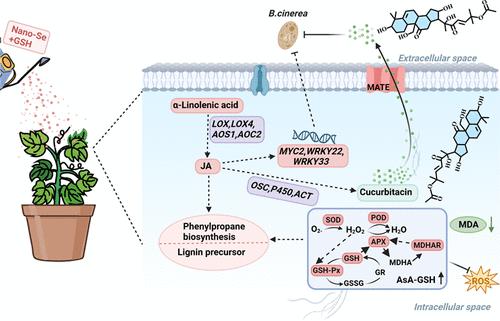Nano-Selenium and Glutathione Enhance Cucumber Resistance to Botrytis cinerea by Promoting Jasmonic Acid-Mediated Cucurbitacin Biosynthesis
IF 15.8
1区 材料科学
Q1 CHEMISTRY, MULTIDISCIPLINARY
引用次数: 0
Abstract
Nano-selenium (Nano-Se), as a biological stimulant, promotes plant growth and development, as well as defense against biotic and abiotic stresses. Glutathione (GSH) is a crucial antioxidant and is also involved in the plant defense response to various stresses. In this study, the efficacy of combined treatment of Nano-Se and GSH (SeG) on the resistance of cucumber plants to Botrytis cinerea was investigated in terms of the plant phenotype, gene expression, and levels of accumulated metabolites using transcriptomic and metabolomic analyses. The exogenous application of SeG significantly enhanced plant growth and increased photosynthetic pigment contents and capacity. Notably, B. cinerea infection was reduced markedly by 41.9% after SeG treatment. At the molecular level, the SeG treatment activated the alpha-linolenic acid metabolic pathway and upregulated the expression of genes responsible for jasmonic acid (JA) synthesis, including LOX (210%), LOX4 (430%), AOS1 (100%), and AOC2 (120%), therefore promoting JA accumulation in cucumber. Intriguingly, the level of cucurbitacin, an important phytoalexin in cucurbitaceous plants, was found to be increased in SeG-treated cucumber plants, as was the expression of cucurbitacin biosynthesis-related genes OSC (107.5%), P450 (440.8%,31.6%), and ACT (414.0%). These genes were also upregulated by JA treatment, suggesting that JA may be an upstream regulator of cucurbitacin biosynthesis. Taken together, this study demonstrated that pretreatment of cucumber plants with SeG could activate the JA signaling pathway and promote cucurbitacin biosynthesis to enhance the resistance of the plants to B. cinerea infection. The findings also indicate that SeG is a promising biostimulant for protecting cucumber plants from B. cinerea infection without growth loss.

纳米硒和谷胱甘肽通过促进茉莉酸介导的葫芦素生物合成增强黄瓜对灰葡萄孢菌的抗性
纳米硒(Nano-Se)作为一种生物刺激剂,能促进植物的生长和发育,并能抵御生物和非生物胁迫。谷胱甘肽(GSH)是一种重要的抗氧化剂,也参与植物对各种胁迫的防御反应。本研究通过转录组和代谢组分析,从植物表型、基因表达和累积代谢物水平等方面研究了纳米硒和谷胱甘肽(SeG)联合处理对黄瓜植物抗灰霉病的功效。外源施用 SeG 能显著促进植物生长,提高光合色素含量和能力。值得注意的是,SeG 处理后,B. cinerea 感染明显减少了 41.9%。在分子水平上,SeG 处理激活了α-亚麻酸代谢途径,并上调了茉莉酸(JA)合成基因的表达,包括 LOX(210%)、LOX4(430%)、AOS1(100%)和 AOC2(120%),从而促进了黄瓜中 JA 的积累。耐人寻味的是,在 SeG 处理的黄瓜植株中,葫芦素(葫芦科植物中的一种重要植物毒素)的含量增加了,葫芦素生物合成相关基因 OSC(107.5%)、P450(440.8%,31.6%)和 ACT(414.0%)的表达量也增加了。这些基因也在 JA 处理后上调,表明 JA 可能是葫芦素生物合成的上游调节因子。综上所述,本研究表明,用 SeG 预处理黄瓜植株可激活 JA 信号通路,促进葫芦素的生物合成,从而增强植株对 B. cinerea 感染的抗性。研究结果还表明,SeG 是一种很有前景的生物刺激剂,可保护黄瓜植株免受 B. cinerea 感染,且不会造成生长损失。
本文章由计算机程序翻译,如有差异,请以英文原文为准。
求助全文
约1分钟内获得全文
求助全文
来源期刊

ACS Nano
工程技术-材料科学:综合
CiteScore
26.00
自引率
4.10%
发文量
1627
审稿时长
1.7 months
期刊介绍:
ACS Nano, published monthly, serves as an international forum for comprehensive articles on nanoscience and nanotechnology research at the intersections of chemistry, biology, materials science, physics, and engineering. The journal fosters communication among scientists in these communities, facilitating collaboration, new research opportunities, and advancements through discoveries. ACS Nano covers synthesis, assembly, characterization, theory, and simulation of nanostructures, nanobiotechnology, nanofabrication, methods and tools for nanoscience and nanotechnology, and self- and directed-assembly. Alongside original research articles, it offers thorough reviews, perspectives on cutting-edge research, and discussions envisioning the future of nanoscience and nanotechnology.
 求助内容:
求助内容: 应助结果提醒方式:
应助结果提醒方式:


